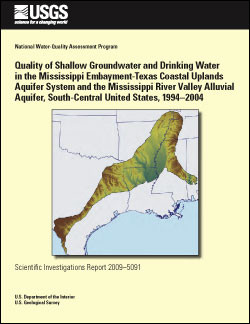
Product Details
- Product Number
- 223586
- Series
- SIR-2009-5091
- Scale
- NO SCALE
- Alternate ID
- SIR2009-5091
- Authors
- HEATHER L WELSH
- Version Date
- 01/01/2009
- Regions
- TX, TN, MS, MO, LA, KY, IL, AR, AL
- Countries
- USA
- Media
- Paper
- Format
- Bound
Additional Details
- Description
-
The Mississippi embayment-Texas coastal uplands aquifer system is an important source of drinking water, providing about 724 million gallons per day to about 8.9 million people in Texas, Louisiana, Mississippi, Arkansas, Missouri, Tennessee, Kentucky, Illinois, and Alabama. The Mississippi River Valley alluvial aquifer ranks third in the Nation for total withdrawals of which more than 98 percent is used for irrigation. From 1994 through 2004, water-quality samples were collected from 169 domestic, monitoring, irrigation, and public-supply wells in the Mississippi embayment-Texas coastal uplands aquifer system and the Mississippi River Valley alluvial aquifer in various land-use settings and of varying well capacities as part of the U.S. Geological Survey's National Water-Quality Assessment Program. Groundwater samples were analyzed for physical properties and about 200 water-quality constituents, including total dissolved solids, major inorganic ions, trace elements, radon, nutrients, dissolved organic carbon, pesticides, pesticide degradates, and volatile organic compounds.
The occurrence of nutrients and pesticides differed among four groups of the 114 shallow wells (less than or equal to 200 feet deep) in the study area. Tritium concentrations in samples from the Holocene alluvium, Pleistocene valley trains, and shallow Tertiary wells indicated a smaller component of recent groundwater than samples from the Pleistocene terrace deposits. Although the amount of agricultural land overlying the Mississippi River Valley alluvial aquifer was considerably greater than areas overlying parts of the shallow Tertiary and Pleistocene terrace deposits wells, nitrate was rarely detected and the number of pesticides detected was lower than other shallow wells. Nearly all samples from the Holocene alluvium and Pleistocene valley trains were anoxic, and the reducing conditions in these aquifers likely result in denitrification of nitrate. In contrast, most samples from the Pleistocene terrace deposits in Memphis, Tennessee, were oxic, and the maximum nitrate concentration measured was 6.2 milligrams per liter. Additionally, soils overlying the Holocene alluvium and Pleistocene valley trains, generally in areas near the wells, had lower infiltration rates and higher percentages of clay than soils overlying the shallow Tertiary and Pleistocene terrace deposits wells. Differences in these soil properties were associated with differences in the occurrence of pesticides. Pesticides were most commonly detected in samples from wells in the Pleistocene terrace deposits, which generally had the highest infiltration rates and lowest clay content.
- Survey Date
- 2009
- Print Date
- 2009
- Height In Inches
- 11.000
- Width In Inches
- 0.200
- Length In Inches
- 8.500
- Two Sided
- Yes
- Pieces
- 1
- Languages
- English



